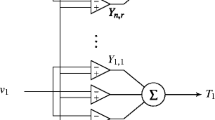Abstract
This paper introduces several algorithms for signal estimation using binary-valued output sensing. The main idea is derived from the empirical measure approach for quantized identification, which has been shown to be convergent and asymptotically efficient when the unknown parameters are constants. Signal estimation under binary-valued observations must take into consideration of time varying variables. Typical empirical measure based algorithms are modified with exponential weighting and threshold adaptation to accommodate time-varying natures of the signals. Without any information on signal generators, the authors establish estimation algorithms, interaction between noise reduction by averaging and signal tracking, convergence rates, and asymptotic efficiency. A threshold adaptation algorithm is introduced. Its convergence and convergence rates are analyzed by using the ODE method for stochastic approximation problems.
Similar content being viewed by others
References
L. Y. Wang and G. Yin, Asymptotically efficient parameter estimation using quantized output observations, Automatica, 2007, 43: 1178–1191.
L. Y. Wang, J. F. Zhang, and G. Yin, System identification using binary sensors, IEEE Trans. Automat. Control, 2003, 48: 1892–1907.
A. Benveniste, M. Metivier, and P. Priouret, Adaptive Algorithms and Stochastic Approximations, Springer-Verlag, Berlin, 1990.
P. Billingsley, Convergence of Probability Measures, J. Wiley, New York, NY, 1968.
H. F. Chen and L. Guo, Identification and Stochastic Adaptive Control, Birkhäuser, Boston, MA, 1991.
Y. S. Chow and H. Teicher, Probability Theory, 3rd Edition, Springer-Verlag, New York, NY, 1997.
K. L. Chung, A Course in Probability Theory, J. Wiley, New York, 1974.
H. J. Kushner, Approximation and Weak Convergence Methods for Random Processes, with Applications to Stochastic Systems Theory, MIT Press, Cambridge, MA, 1984.
L. Ljung, System Identification: Theory for the User, Englewood Cliffs, NJ: Prentice-Hall, 1987.
J. D. Hamilton and R. Susmel, Autoregressive conditional heteroskedasticity and changes in regime, J. Econometrics, 1994, 64: 307–333.
U. Holst, G. Lindgren, J. Holst, and M. Thuvesholmen, Recursive estimation in switching autoregressions with a Markov regime, J. Time Series Anal., 1994, 15: 489–506.
E. W. Kamen, P. P. Khargonekar, and A. Tannenbaum, Control of slowly-varying linear systems, IEEE Trans. Automat. Contr., 1989, AC-34: 1283–1285.
G. Yin and V. Krishnamurthy, Analysis of LMS algorithm for slowly varying markovian parameters — Tracking slow hidden markov models and adaptive multiuser detection in DS/CDMA, IEEE Trans. Inform. Theory, 2005, 51: 2475–2490.
G. Zames, L. Lin, and L. Y. Wang, Uncertainty principles and identification n-width for LTI and slowly time-varying systems, IEEE Trans. Automat. Contr., 1994, 39: 1827–1837.
L. Y. Wang, G. Yin, J. F. Zhang, and Y. L. Zhao, System Identification with Quantized Observations: Theory and Applications, Birkhäuser, Boston, 2010.
H. J. Kushner and G. Yin, Stochastic Approximation and Recursive Algorithms and Applications, 2nd Ed., Springer-Verlag, New York, 2003.
L. Y. Wang, G. Yin, J. F. Zhang, and Y. L. Zhao, Space and time complexities and sensor threshold selection in quantized identification, Automatica, 2008, 44: 3014–3024.
B. C. Kuo, Digital Control Systems, 2nd. Edition, Oxford University Press, 1995.
K. Ogata, Morden Control Engineering, 4th Edition, Prentice Hall, 2002.
Author information
Authors and Affiliations
Corresponding author
Additional information
The research of Leyi Wang was supported in part by the National Science Foundation under ECS-0329597 and DMS-0624849, and in part by the Air Force Office of Scientific Research under FA9550-10-1-0210; the research of Gang George Yin was supported by the National Science Foundation under DMS-0907753 and DMS-0624849, and in part by the Air Force Office of Scientific Research under FA9550-10-1-0210; the research of Weixing Zheng was supported in part by a research grant from the Australian Research Council.
Rights and permissions
About this article
Cite this article
Wang, L., Yin, G.G., Li, C. et al. Signal estimation with binary-valued sensors. J Syst Sci Complex 23, 622–639 (2010). https://doi.org/10.1007/s11424-010-0149-4
Received:
Revised:
Published:
Issue Date:
DOI: https://doi.org/10.1007/s11424-010-0149-4




